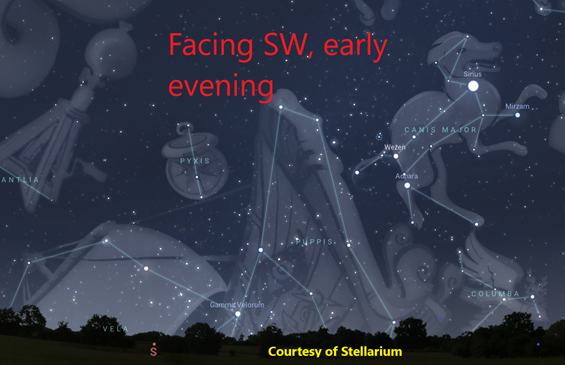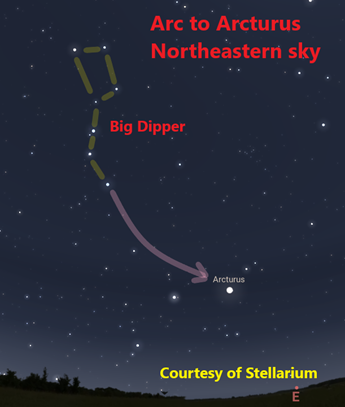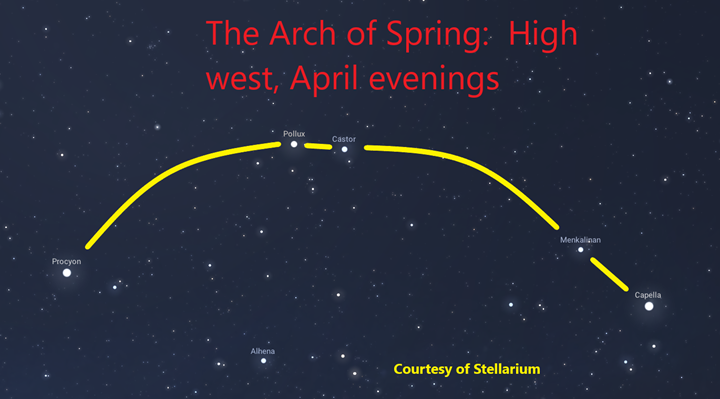ARKS, ARCS, AND ARCHES IN THE APRIL SKY
At first glance, the night sky, especially when viewed from a location without a huge amount of light pollution, may seem to be a confusing jumble of countless stars. There are several ways to learn your way around the sky, including learning some of the mythology associated with the various stars and constellations, to help make them more memorable. Another way might be to imagine your own shapes and patterns in the stars, which may or may not correspond to the actual constellations in the sky. As the skies get dark after sunset in April, the brilliant bluish white star Sirius, brightest of any in the sky, glimmers in the southwestern sky. When seen low in the sky as it currently is, Sirius often twinkles fiercely through the thicker atmosphere close to the horizon.
Sirius shines so brightly partly because it is 25 times more luminous than the Sun, but even more so because it is the closest star besides the Sun that is visible to the naked eye from our latitude, at a distance of 8.6 light years, or over 50 trillion miles. Look to the lower left of Sirius for a triangle of stars, which form the hindquarters and tail of the constellation Canis Major, the sky’s greater dog. The rest of the stars of this celestial canine, mostly making up the Dog’s body and paws, are much dimmer and harder to see from near the city, but binoculars can help. Sirius is known as the Dog Star, and it can help point the way to our celestial ark.
The stars to the left and lower left of Canis Major make up a celestial ship, usually associated with Jason and the Argonauts, who are said to have sailed in search of the Golden Fleece. In ancient times, the stars of Argo Navis stood higher and could be seen fairly well from mid-northern latitudes. However, Earth’s axis nutates, or wobbles over the centuries, and now only Argo’s northernmost stars can be glimpsed from mid-northern latitudes, very low on the horizon on clear dark nights. Binoculars can help you locate some of the dimmer and lower stars shown on the chart below. Argo was so huge that all efforts of cataloguing the stars were exhausted, causing it to be divided into three separate constellations- Puppis, the Stern (partly visible from our latitudes), Vela, the Sail (partly visible), and Carina, the Keel (never visible from St. Louis), with the original constellation considered defunct.
Like all constellations, these stars have represented different things to different people- for example, the ancient Egyptians saw them as representing the god Osiris’ boat. Others, including nineteenth century astronomer Julius Schiller, have seen Noah’s Ark in the stars of Argo.

Our Arc of the month can be found at the opposite side of the sky, in the north. The Big Dipper appears to stand up on its handle at this time of year. It is very easy to follow the “arc” of the handle to find Arcturus, the second brightest star in the night sky as seen from St. Louis. Arcturus is still one of the nearer stars at a distance of 37 light years from us, but this is more than four times farther than Sirius, and thus it looks quite a bit dimmer. Look closely, and you can see that in addition to the difference in brightness, there is also a decided difference in color- with Sirius shining somewhat bluish white and Arcturus yellowish, slightly orange, due to the difference in their temperatures. Since stars are so far away that they appear as dots, even as seen in a telescope, one thing that is not apparent by eye is Arcturus’ huge size- about 25 times larger and 170 times more luminous than the Sun.

Lastly, we are now entering the time of year when the famous “Arch of Spring” stands out the best. During April, it looks the best in the late evening, and in May, soon after sunset. Face west, and then notice two bright stars side by side in the western sky- Castor and Pollux, the famous Gemini twins. The short line between them can be imagined as the keystone of the Arch, with the South (left) leg going out to the bright star Procyon, and the North (right) leg to Menkalinan and Capella. You can learn a lot more about the Arch of Spring in the May 2021 issue of this blog. It looks rather flattened out compared to our very own Gateway Arch, but it is cool to know that there is at least one prominent Arch in the sky!

Our 2022 Gateway to the Stars schedule is now available: Program dates will be May 28, June 12, July 10, August 14, September 3 & October 8. An educational program will take place in the Park’s Education Classroom at 6:45 pm, regardless of the weather. If skies are reasonably clear, free telescope viewing will take place on the plaza outside the West Entrance of the Gateway Arch Visitor Center.
